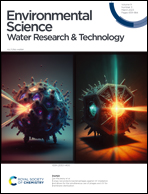Occurrence, removal efficiency and exposure assessment of bisphenols in drinking water treatment plants†
Abstract
Bisphenols (BPs) are prevalent in various environmental media and have endocrine-disrupting effects as well as biological toxicity, so it is necessary to study the occurrence of BPs in drinking water. In this study, nine BPs were analyzed in raw and finished water samples collected from 9 drinking water treatment plants (DWTPs) in the Taihu Lake Basin in August 2019 and December 2019. The removal efficiencies of BPs by treatment processes in DWTPs were investigated, and the estrogenic activity and human exposure risk of BPs were evaluated. The main results are as follows: nine BPs in the raw water were detected, with detection frequencies ranging from 89% to 100%. BPA was the main bisphenol substance in the raw water in summer and winter, with mean concentrations of 19.7 ng L−1 and 6.44 ng L−1, respectively. The conventional treatment processes in DWTPs had a considerable removal efficiency of BPs with average removal efficiencies for individual bisphenol ranging from 26.7% to 80.2%. There was no significant seasonal difference in the average removal efficiency of BPs, except that the removal effect of BPF became better in winter. The best single removal process was carbon filtration, followed by pre-ozonation, with average removal efficiencies of 28.3% and 14.6%, respectively. In general, a combination of physical adsorption and biological oxidation had the best removal effect, while single chemical oxidation was also effective for the removal of BPs. The health risk evaluation of drinking water showed that the mean 17β-estradiol equivalent quantity (EEQt) of ∑BPs in the effluent was 2.61 × 10−2 ng E2 L−1, indicating no interference with the human endocrine system. Adult males had a higher EDI than adult females, while boys had a lower EDI than girls of all ages. By using the RfD value of BPA as a reference it can be concluded that BPs did not pose a greater health risk through drinking water.



 Please wait while we load your content...
Please wait while we load your content...